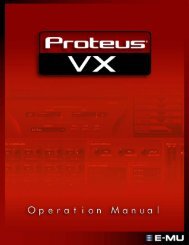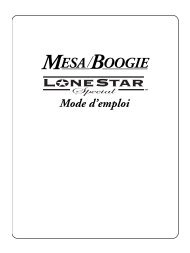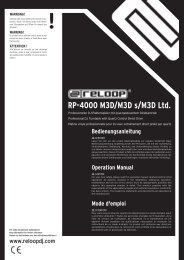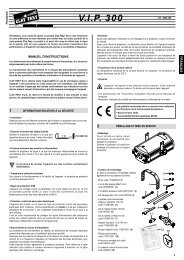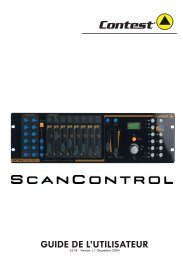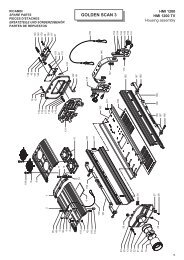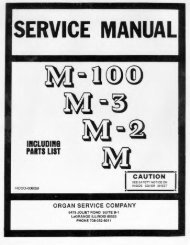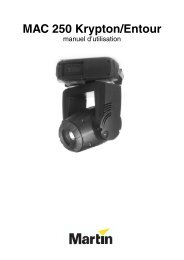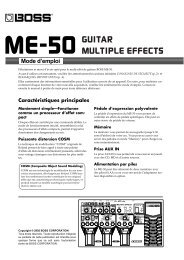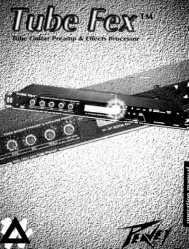Sequential Circuits Prophet-5 Service Manual - Audiofanzine
Sequential Circuits Prophet-5 Service Manual - Audiofanzine
Sequential Circuits Prophet-5 Service Manual - Audiofanzine
You also want an ePaper? Increase the reach of your titles
YUMPU automatically turns print PDFs into web optimized ePapers that Google loves.
2-2 THE PROPHETThe <strong>Prophet</strong> is a subtractive, analog synthesizer suitable for performance or studio use. It providesinstantaneous patch repeatability and polyphonic capability without the limitations of organ technologyor fixed presets. The term "digital-analog hybrid" is often used to describe the <strong>Prophet</strong>. It means thedigital computer controls the analog audio sources and modifiers. The computer itself generates nosound (except for the A-440 reference).Figure 2-2 diagrams the <strong>Prophet</strong> at the most general level. Instead of controlling the synth directly, thekeyboard and most controls are processed through a microcomputer system. The system provides a wayto store all of the switch and knob settings which form a patch, and solves the problem of generatingfive sets of oscillator (OSC) and filter (FILT) CVs and GATEs from a single keyboard. The Common Analogcircuitry mixes the few non-processed controls with processed signals for the voices. Although only onevoice is depicted on the control panel, the black knobs and switches patch the five voices identically.This makes the voices homophonous—they sound alike—with pitch differences corresponding to (atmost) five simultaneously-held keys.DIGITALANALOGCOMMONANALOG/7\CONTROL PANEL/KEYBOARDMICROCOMPUTER; 7 SYSTEM^ \^ li75 -VOICESYNTHFigure 2-2PROPHET GENERAL BLOCK DIAGRAMFigure 2-3 shows the principle funaions of the four main blocks. Beginning with AUDIO OUT, the voiceoutputs are combined and overall volume set by the VOL VCA controlled directly from the controlpanel. Each voice isa complete synthesizer with two VCOs, a MIXER, VCF, FINAL VCA, and two ENVGENs. Each of the ten VCOs has its own FREQ CV, which allows the computer to individually fine-tunethem and allows the voices to follow separate keys. Each voice receives its own GATE, which triggers thetwo envelope generators with each keystroke.Allswitch commands and most CVs are generated by the computer. Non-processed CVs includeMASTER TUNE, PITCH-bend, and WHEEL-MODulation which are mixed in the Common Analogcircuitry. The Common Analog circuitry also requires a few switch commands.The microcomputer performs the task of voice assignment. It decides which held keys sound whichvoices through the OSC and FILT CVs and GATEs. Voice 1 is assigned to the first key hit. Voice 2 to thesecond key, and so on. After the five initial assignments the system is"last note priority." The earliestusedvoice isreassigned to each new note played. Repeated notes key the same voice. For example,holding C, D, E, F, and G, sustains Voices 1, 2, 3, A, 5, respectively. Adding A "steals" Voice 1C-key, whose pitch disappears even though the key may stillbe held.from the2-4



